A wrought iron fence is aesthetically appealing and durable. However, it is prone to rusting.
If you want to keep your fence rust-free, you need to:
- wash it regularly
- cover it with protective agents
- paint it
- remove any rust patches as soon as they form.
Here are the maintenance tips and tricks that you need to know.
What we cover
ToggleHow Do You Keep Rust From Forming on Your Wrought Iron Fence?
If you want to prevent rust, you should do the following:
Clean It Regularly
Dust, dirt, sand, and debris can scratch off the protective coating that often shields the iron from rust. They also retain water, something that then increases the odds of corrosion.
Therefore, getting rid of any sand, debris, dust, or dirt buildup as soon as you notice it, is an effective way of avoiding ending up with a rusty wrought iron fence.
For the best results, clean it using:
- a sponge,
- soap,
- warm water,
- an old toothbrush(for hard-to-reach areas), and
- a hard-bristled brush.
The combined strategy of wiping and scrubbing will be enough to rid your fence of any dirt or debris.
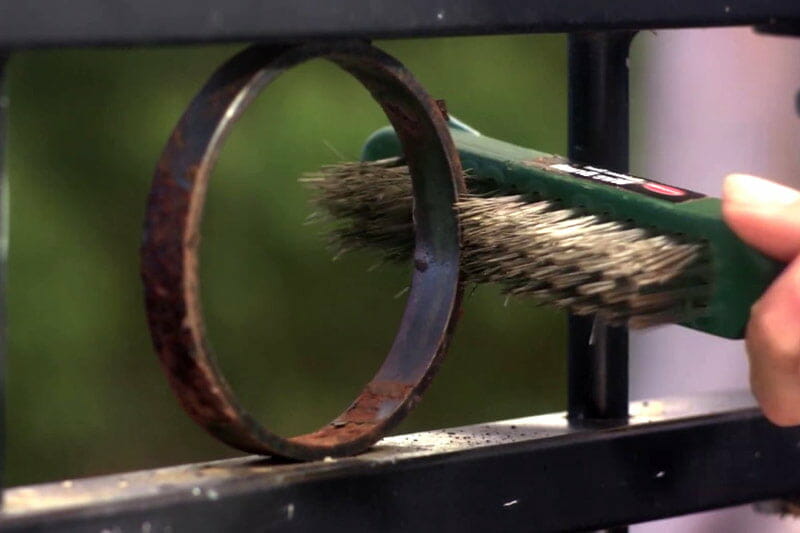
Coat It
An extra protective layer over the wrought iron fence will go a long way towards shielding it from premature corrosion.
You can protect your fence by using any of the following.
- water-repellent sprays
- car wax
- baby oil
- mineral oil
- silicone products
- epoxy enamels
- zinc primers
- powder coating. It can be epoxy, polyester, acrylic, or urethane.
- oil-based coating
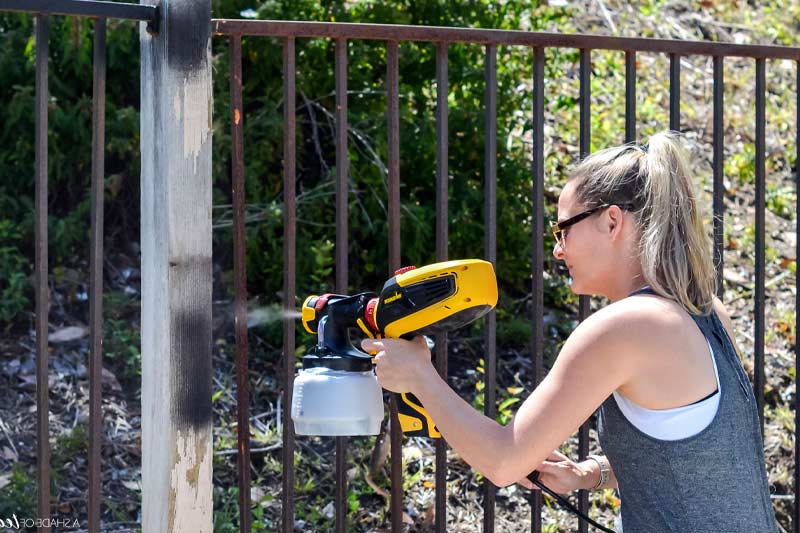
Inspect It
Inspecting your fence on a regular basis will help to keep it rust-free because it will allow you to catch problems before they get out of hand.
With regular fence inspections, you will be able to:
- remove any dirt and debris before it has time to trigger corrosion
- seal any scratched or peeled coated sections before rusting sets in
- scrub off any rust deposits before the rusting spreads
- rust-proof the fence before the problem gets worse
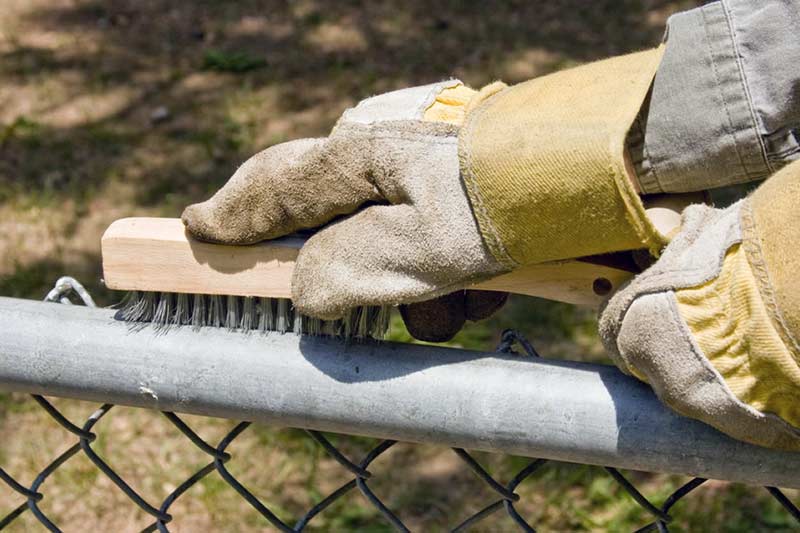
Wipe It
Constantly exposing your fence to moisture will accelerate the rate at which it becomes corroded. Therefore, if you have any water equipment, it is best to use it away from your fence. This includes sprinklers and water pumps.
If you can’t use them away from your fence and water spills land on it, you should always make an effort to wipe it down immediately.
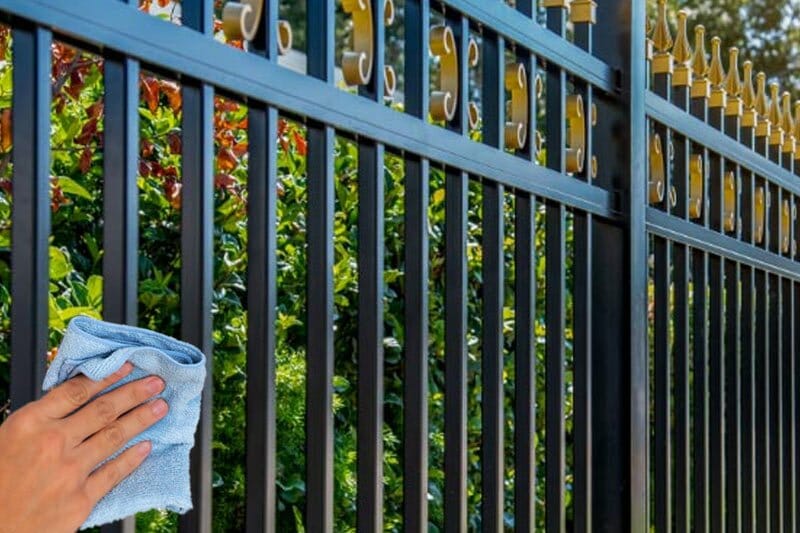
Scrub It
To keep your fence, or rusted fence post, from getting overwhelmed with rust, you need to remove rust spots as soon as they start forming. This way, you will keep the corrosion from spreading. You will also be able to preserve the structural integrity of the metal fence.
The best way to remove rust spots is to scrub them off. You can use either steel wool or sandpaper to remove these spots. You can also use a chemical rust remover to achieve the same results.
A small metallic brush can help if the rust is in a hidden area with a bend – fence post and fence repair may sometimes be needed before beginning the removal process.
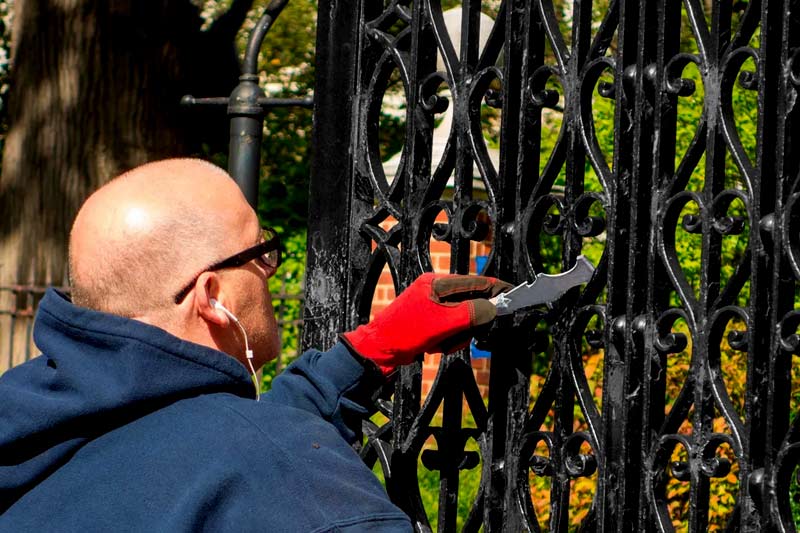
Paint It
Rust-inhibiting paint provides an additional layer of protection. This is because:
- It shields the fence from moisture and oxygen. This helps to keep it from rusting as these are the two elements that are essential for rust formation.
- It also provides protection against scratching. In doing so, it helps to maintain the integrity of any protective layer that the fence may have. This in turn helps to prolong its lifespan.
Therefore, if you want your fence to have a long lifespan, you should protect it from rust-triggered damage by painting it.
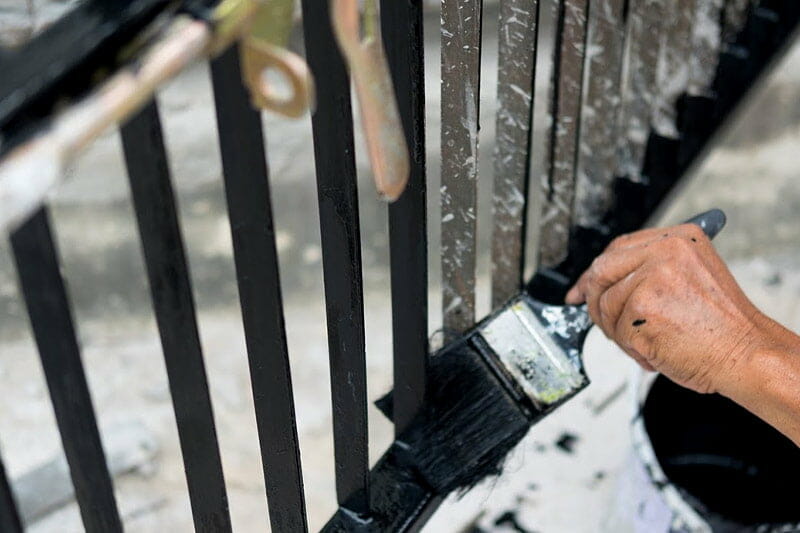
Trim Vegetation
You should also trim any vines, weeds, or any other plants that are in close proximity to the fence.
These plants often trap water. And by collecting moisture around the fence, they prolong the period that it is exposed to moisture. Therefore, to protect your fence, you need to ensure that you trim any vegetation that is next to it on a regular basis.
How Do You Remove Rust From Wrought Iron Fences?
One of the main things that stick out in a metal vs. wood fencing comparison is that while durable, wrought iron fencing rusts. The good news is that no matter how much rust your fence accumulates, you can always remove it.
Here is what you can do to remove rust from a rusty wrought iron fence.
- Use steel wool. If you have tiny rust spots on your fence, then scrubbing with metallic wool will be more than enough to get them off your fence.
- Use sandpaper. You can use 80-grit sandpaper to rub away the rust. This will not only remove the rust, but also make the paint surface smoother.
- Use a sandblaster. A sandblaster is also an effective way of getting rid of vast patches of rust at a faster rate.
- Use a metal-bristle brush. If all you have are a few patches of rust, then methodically scrubbing them off with a metal-bristle brush is a cheap and effective way of getting the job done.
- Use a brush attachment with a cordless drill. A cordless drill will allow you to get through the scrubbing process faster. It will also save you from having to exert yourself.
- And given that there are an endless number of brush attachments that you can use, it will allow you a lot of flexibility especially when it comes to removing rust from hard-to-reach areas.
- Use an aluminum oxide grinding wheel. This wheel is good at grinding away rust patches. To use it, simply attach it to a rotary tool and then direct it to the affected areas.
Conclusion
In general, the key to keeping your gate or fence free of rust is regular maintenance. Maintenance activities like giving it a fresh coat of paint and covering it with a rust-inhibiting primer can also enhance its appearance – by increasing the odds of ending up with a smooth, attractive, and even coat.
FAQ's
Here are the steps that you should follow.
- Wash. Dirt and debris will interfere with the integrity of your paintwork. For the best results, you need to wash them off. Do so by using soap, warm water, and a sponge.
- Rinse. After you are done, rinse off the soapy water by spraying it with a hose.
- Scrape. Once it dries, take sandpaper or a steel-bristled brush and use it to scrape off any existing traces of rust.
- Neutralize. Washing and scrubbing it is not enough. To guarantee a rust-free surface, you will need to use a rust neutralizer.
- Use either a mixture of lemon juice and vinegar or commercial rust neutralizers to not only get rid of existing rust, but also minimize the odds of future rust attacks.
- Prime. Apply two or more thick coats of a rust-inhibiting primer as a base coat to make the iron surface more paint-friendly.
- For the best results, you should mix the primer with the paint conditioner. The combination of the rust-resistant primer and the paint conditioner will give it double the protection and a smoother finish.
- Paint. Use a brush to apply an oil-based metal paint of your choosing.
- Wax. After the paint dries, use automotive wax to finish it — that is if the wrought iron is non-textured. If not, use baby oil or mineral oil.
If you are repainting or recoating an old iron fence, you will have to spend extra time removing old paint, coatings, or rust.
Here are the techniques that you should consider using when removing paint or any other protective layer.
- Scrubbing with a steel-bristle brush
- Spraying with phosphoric acid
- Filing with a metal file or an 80-grit sandpaper
- Brushing with a hard-bristled brush
This is a step that is necessary in order to ensure lasting paintwork. By scrubbing off old paint and other coatings, you also guarantee a smoother finish.












